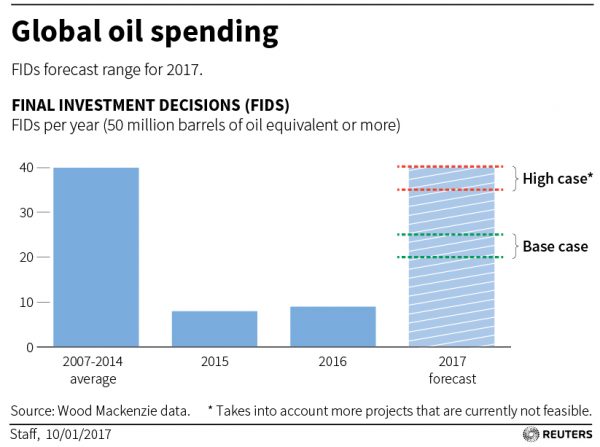New oil projects to double in 2017, Wood Mackenzie says

Wood Mackenzie says US shale oil production should account for most gains because it is relatively cheap and quick to develop.
Wood Mackenzie says spending to rise to $450 billion after two years of cuts
By Ron Bousso
LONDON, Jan 11 (Reuters) – Oil and gas companies will increase spending in 2017 and more than double new project developments as they gain confidence that a two-year oil price slump is behind them, consultancy Wood Mackenzie said.
The upbeat outlook follows a more than 20 per cent rise in benchmark crude oil prices in the past two months to around $55 a barrel on the back of an agreement by major producers to trim output.
“We’ve just come through two years of gloom and lots of costs cutting and now we are cautiously optimistic there will be a start of recovery in 2017,” Malcolm Dickson, a principal oil and gas analyst at Wood Mackenzie, said.
According to WoodMac’s global upstream outlook for 2017, exploration and production spending is expected to rise by 3 per cent to $450 billion. This is still 40 per cent below 2014 levels.
Geographically, the increased activity will vary hugely. U.S. shale oil production is expected to account for most of the gains because it is relatively cheap and quick to develop, in some cases it can take only 6 months.
Shale was the main driver of the recent supply glut and also experienced the sharpest declines in terms of output during the downturn.
Production in the most attractive shale areas, particularly in the Permian Basin in Texas, is currently profitable with oil at $40 to $60 a barrel, according to WoodMac analyst Tom Ellacott.
U.S. shale oil production is expected to grow by around 300,000 b/d in 2017 to around 4 million b/d, according to WoodMac estimates.
WoodMac forecasts oil prices to average $57 a barrel in 2017 and gradually increase to $85 a barrel in 2020 as supplies decrease due to the investment cutbacks of the past few years.
Aside from onshore U.S. production, oil companies globally have also been able to reduce costs of field developments sharply by simplifying engineering plans and lowering contractor and rig rates.
Costs have fallen by 20 per cent since 2014 and are expected to decline by an additional 5 per cent this year, according to Dickson.
The savings are having a profound impact on project profitability, including costlier deepwater projects, some of which are profitable at oil prices of $50 to $60 a barrel.
The number of final investment decisions for projects with resources bigger than 50 million barrels of oil equivalent will more than double in 2017 to 20 to 25 from only 9 in 2016.
Projects most likely to get the nod include Exxon Mobil’s Liza discovery offshore Guyana, deepwater projects in Brazil and in the Gulf of Mexico. BP late last year approved the development of the second phase of the Mad Dog field in the Gulf of Mexico and its partners will decide on it this year.
But the pick up in activity is still not enough to cover a growing supply/demand gap, which WoodMac expects will widen to 20 million barrels per day by 2025, based on current development plans.
“You need the new projects to be sanctioned by 2020 to meet future supply gap,” Ellacott said.
(Reporting by Ron Bousso. Editing by Jane Merriman)








